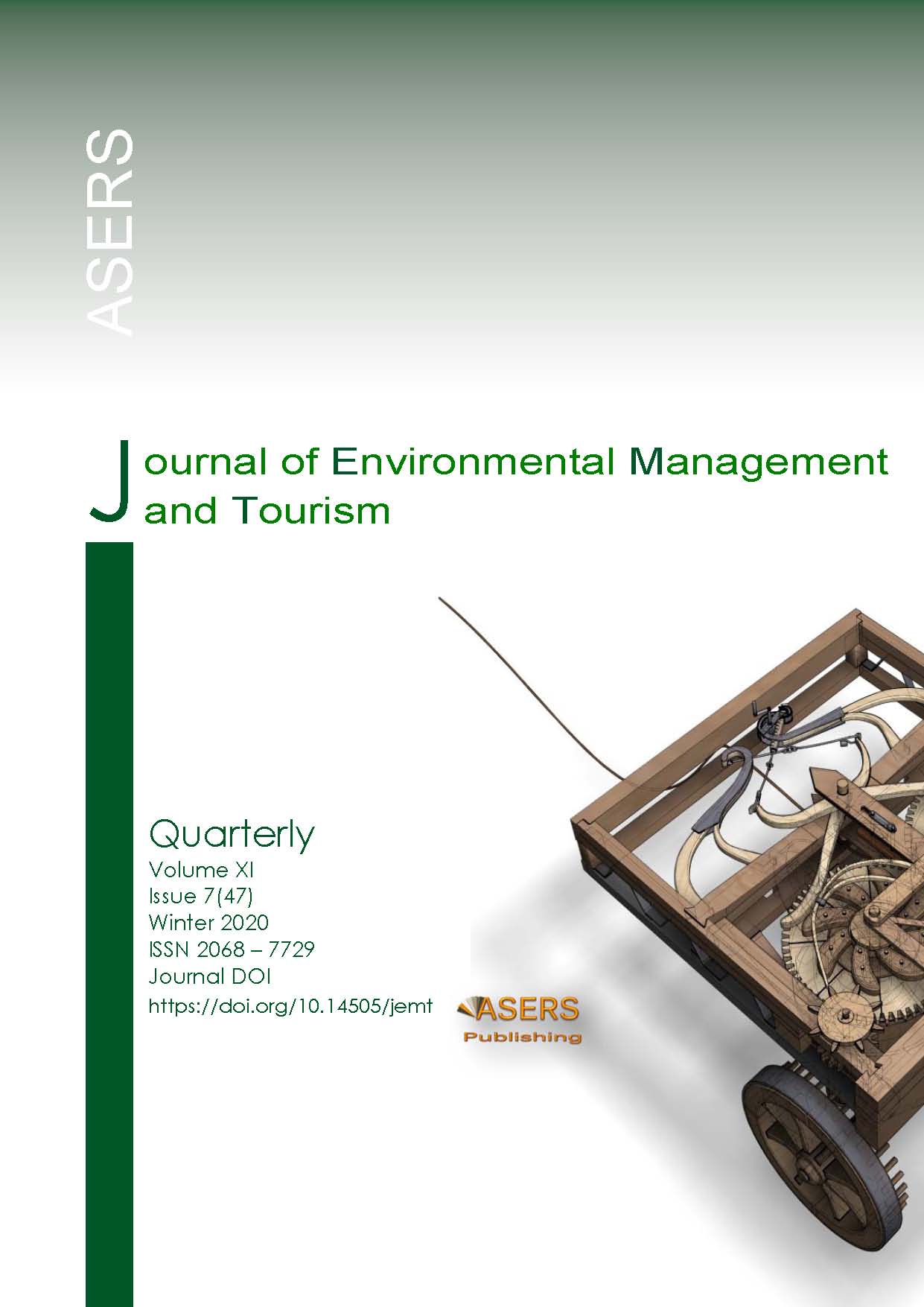Analysis and Assessment of Seismic Hazard for the Azov-Black Sea Recreation Area
Abstract
One of the geological structures accountable for the implementation of seismic potential of the region is the largest vertical faults in the Earth’s interior, where earthquake foci are usually located. This article is aimed at developing a better method for calculation of stresses and strains that occur in such seismogenic areas. According to the results of the analysis of data collected during the expeditionary work, the geophysical medium is modeled by a block structure in the form of a half-space with a cut rectangular parallelepiped, which is divided into five block elements. The state of material in the geological medium is described in each block by motion equations for a homogeneous, isotropic elastic medium in the Lamé form. Following the block element method, the algorithm of the differential factorization method is implemented in each block. Based on the numerical analysis results, the main trends in contact stresses and dynamics of displacement amplitudes were determined depending on the mechanical property values of the block material and the geometric parameters of the structure.
References
[2] Babeshko, V.A., Evdokimova, O.V., and Babeshko, O.M. 2018. On the possibility of predicting some types of earthquake by a mechanical approach. Acta Mechanica, 229(5): 2163–2175. DOI:https://doi.org/10.1007/s00707-017-2092-0
[3] Babeshko, V.A., et al. 2009. The differential factorization method for a block structure. Doklady Physics, 54(1): 25–28. DOI: https://doi.org/10.1134/S1028335809010078
[4] Babeshko, V.A., et al. 2018. Origin of Starting Earthquakes under Complete Coupling of the Lithosphere Plates and a Base. Doklady Physics, 63(2): 70–75. DOI: https://doi.org/10.1134/S1028335818020015
[5] Brady, B.T. 1975. Theory of earthquakes. II. Inclusion theory of crustal earthquakes. Pure and Applied Geophysics, 113: 149–168. DOI: https://doi.org/10.1007/BF01592907
[6] Di Toro, G., et al. 2011. Fault lubrication during earthquakes. Nature, 471(7339): 494–498. DOI:https://doi.org/10.1038/nature09838
[7] Doglioni, C. 2018. A classification of induced seismicity. Geoscience Frontiers, 9(6): 1903–1909. DOI:https://doi.org/10.1016/j.gsf.2017.11.015
[8] Flambaum, V., Martin, G., and Pavlov, B. 2020. A resonance interaction of seismogravitational modes on tectonic plates. Operator Theory: Advances and Applications, 276: 305-334. DOI:https://doi.org/10.1007/978-3-030-31531-3_18
[9] Fraser-Smith, A.C. 2008. Ultralow-Frequency Magnetic Fields Preceding Large Earthquakes. EOS, 89(23): 211.
[10] Geller, R.J. 1997. Earthquake prediction: a critical review. Geophysical Journal International, 131: 425–450. DOI: https://doi.org/10.1111/j.1365-246X.1997.tb06588.x
[11] Guglielmi. A.V., Zotov. O.D. 2012. Magnetic perturbations before the strong earthquakes. Izvestiya, Physics of the Solid Earth, 48(2): 171–173. DOI: https://doi.org/10.1134/S1069351312010065
[12] Hattori, K. 2004. ULF Geomagnetic сhanges associated with large earthquakes. Terrestrial, Atmospheric and Oceanic Sciences, 15(3): 329–360.
[13] Hayakawa, M. 1999. Atmospheric and ionospheric electromagnetic phenomena associated with earthquakes. Terra Sci. Pub Co.
[14] Ide, S., Beroza, G.C. 2001. Does apparent stress vary with earthquake size? Geophysical Research Letters, 28(17): 3349–3352. DOI: https://doi.org/10.1029/2001GL013106
[15] Jacobs, T. 2014. Searching for solutions to induced seismicity. Journal of Petroleum Technology, 66(9). DOI:https://doi.org/10.2118/0914-0060-JPT
[16] Langer, L., Ragon, T., Sladen, A., and Tromp, J. 2020. Impact of topography on earthquake static slip estimates Tectonophysics 791, no. 228566, DOI: https://doi.org/10.1016/j.tecto.2020.228566
[17] Mokarram, M., Pourghasemi, H.R., Tiefenbacher, J.P. 2020. Using Dempster–Shafer theory to model earthquake eventsicle. Natural Hazards, 103(2): 1943–1959. DOI: https://doi.org/10.1007/s11069-020-04066-w
[18] Moretto, T., Sibeck, D. G., and Watermann, J.F. 2004. Occurrence statistics of magnetic impulsive events. Annales Geophysicae, 22: 585–602. DOI: https://doi.org/10.5194/angeo-22-585-2004
[19] Pan, X., Málaga-Chuquitaype, C. 2020. Seismic control of rocking structures via external resonators Earthquake. Engineering and Structural Dynamics, 49(12): 1180-1196. DOI: https://doi.org/10.1002/eqe.3284
[20] Pavlova, A.V., et al. 2019. Assessment of the environmental consequences caused by endogenous and anthropogenic hazards for the Azov recreation area. Journal of Environmental Management and Tourism, X(7): 1445-1457. DOI: http://dx.doi.org/10.14505/jemt.v10.7(39).02
[21] Ratner, S., Zaretskaya, M. 2020. Evaluating Efficiency of Russian Regional Environmental Management Systems. Quality – Access to Success, 21(175): 120-125.
[22] Sadovskiy, M.A., Bolkhovitinov, L.G., Pisarenko, V.F. 1987. Deformation of geophysical environment and seismical process. Nauka (in Russian).
[23] Scholz, C.H., Sykes, L.R., Aggarwal, Y.P. 1973. Earthquake prediction: a physical basis. Science, 181: 803–810. DOI: https://doi.org/10.1126/science.181.4102.803
[24] Suckale, J. 2009. Induced Seismicity in Hydrocarbon Fields. Advances in Geophysics, 51(С): 55–106. DOI:https://doi.org/10.1016/S0065-2687(09)05107-3
[25] Temerdashev, Z.A., Pavlenko, L.F., Korpakova, I.G., Ermakova, Y.S. 2018. Analytical Aspects of the Determination of the Total Concentration and Differentiation of Anthropogenic and Biogenic Hydrocarbons in Aquatic Ecosystems. Journal of Analytical Chemistry, 73(12): 1137-1145. DOI:https://doi.org/10.1134/S1061934818120092
[26] Xiao, L., Lapusta, N., and Rosakis, A.J. 2007. Pulse-like and crack-like ruptures in experiments mimicking crustal earthquakes. Proceedings of the National Academy of Sciences, 104(48): 18931–18936. DOI:https://doi.org/10.1073/pnas.0704268104
[27] Zotov, O.D., Guglielmi, A.V., and Sobisevich, A.L. 2013. On magnetic precursors of earthquakes. Izvestiya. Physics of the Solid Earth, 49(6): 882–889. DOI: https://doi.org/10.1134/S1069351313050145
Copyright© 2025 The Author(s). Published by ASERS Publishing 2025. This is an open access article distributed under the terms of CC-BY 4.0 license.
